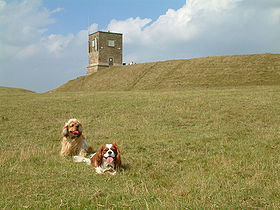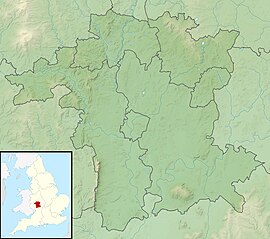Bredon Hill
| Bredon Hill | |
|---|---|

The top of Bredon Hill, with Parsons Folly and the inner rampart of Kemerton Camp
|
|
| Highest point | |
| Elevation | 299 m (981 ft) |
| Prominence | 257 m (843 ft) |
| Parent peak | The Wrekin |
| Listing | Marilyn |
| Coordinates | 52°03′37″N 2°03′46″W / 52.06016°N 2.06267°WCoordinates: 52°03′37″N 2°03′46″W / 52.06016°N 2.06267°W |
| Geography | |
| Location | Worcestershire, England |
| OS grid | SO958402 |
| Topo map | OS Landranger 150 |
Bredon Hill is a hill in Worcestershire, England, south-west of Evesham in the Vale of Evesham. The summit of the hill is in the parish of Kemerton, and it extends over parts of eight other parishes (listed below). The hill is geologically part of the Cotswolds and lies within the Cotswolds Area of Outstanding Natural Beauty. However, as the result of erosion over millions of years, it now stands isolated in the Vale of Evesham.
At the summit, adjacent to Kemerton Camp, is a small stone tower called Parsons Folly (or the Banbury Stone Tower) which stands at GPS coordinates (52.059963, -2.064606). The tower was built in the mid-18th century for John Parsons, MP (1732–1805), squire of Kemerton Court and intended as a summer house, from which a more extensive view of the surrounding countryside could be seen. The 981-foot (299 m) natural height of the hill contributes to the final height of the tower, whose top now reaches 1,000 feet (305 m). A similar tower on Leith Hill increases the overall height from 965 to 1,029 ft (294.1 to 313.6 m). The folly (tower) became a well-known county landmark, and was believed to have inspired the building of Broadway Tower. The current owners, Overbury Estate, lease out the tower as a mobile phone base station, and a number of large aerials have been fitted to its exterior.
At the summit of the hill, there are the remains of earthworks from an Iron Age hill fort known as Kemerton Camp, which is believed to have been abandoned in the 1st century A.D. after a considerable battle.
There are also Roman earthworks and a number of ancient standing stones on the hill. One large stone at the summit is called the Banbury Stone, deriving from 'Baenintesburg', a name for the fort in the 8th century. It is known colloquially as the 'Elephant Stone' because of its resemblance to that animal. Another pair of stones below the summit are known as the King and Queen Stones. Local legend tells that if you pass between them you will be cured of illness.
...
Wikipedia

